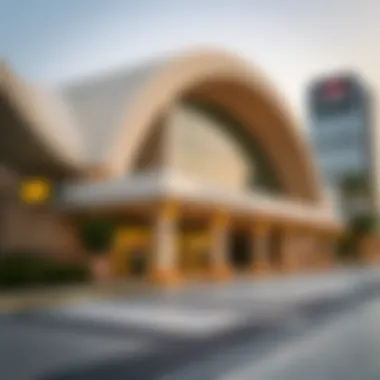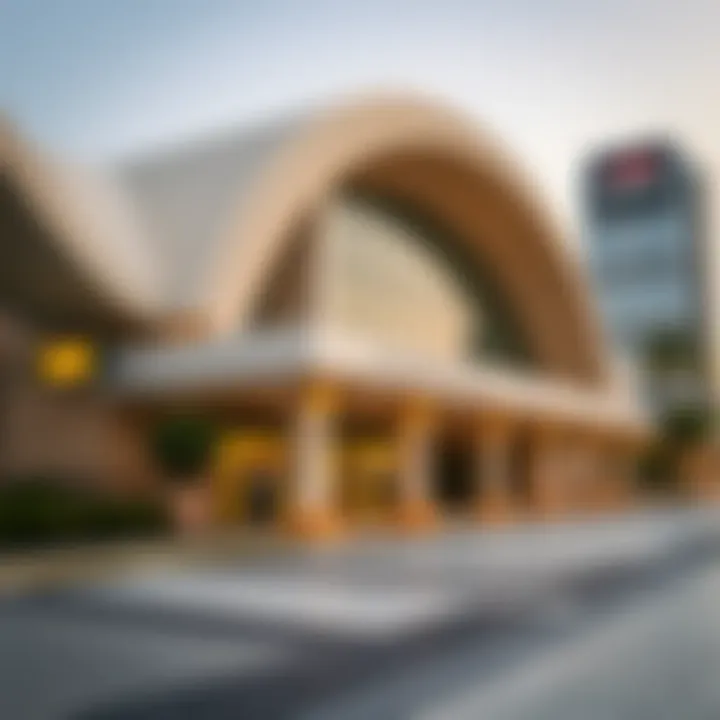In-Depth Look at Al Garhoud Metro Station in Dubai


Intro
The Al Garhoud Metro Station stands as a vital artery within Dubai's sprawling transport network. Not just a simple stop along the Red Line of the Dubai Metro, this station embodies a convergence of urban planning, architectural vision, and economic potential. As we unpack the layers surrounding this essential transport hub, we'll explore how it shapes not only the daily commutes of its users but also the broader real estate landscape surrounding it.
Nestled in a rapidly developing area, Al Garhoud Metro Station serves as a linchpin for both residents and visitors. Its strategic position connects vital sectors of the city, making it an attractive locus for real estate development. The significance of this station extends beyond the physical structure; it plays a pivotal role in enhancing mobility while simultaneously influencing property values and demand in the neighborhood.
This article aims to illuminate the various facets of Al Garhoud Metro Station, from its structural design and operational capacities to its impact on local markets and investment dynamics. So, whether you are a potential homebuyer, a seasoned investor, or simply someone keen to understand Dubai's urban evolution, there's a wealth of insights waiting to be uncovered.
Preamble to Al Garhoud Metro Station
Al Garhoud Metro Station stands as a pivotal axis in Dubai's sprawling transportation network. Located in the heart of a vibrant and diverse community, this station does not just serve as a transit point but embodies the city's commitment to modern mobility and infrastructural evolution. The prominence of this station transfers from its structural significance to its broader implications on local development, accessibility, and the enhancement of everyday commuting for residents, tourists, and business professionals alike.
Importance of Al Garhoud Station
The benefits of Al Garhoud Metro Station are manifold. Initiated as part of the Dubai Metro project, which began construction in 2006, its design reflects a blend of functionality and aesthetic appeal. This venue plays a crucial role in reducing road congestion, thereby lessening the environmental footprint associated with private car travel. Highlights of its importance include:
- Facilitated Access: The station links residential areas, commercial hubs, and educational institutions, fostering greater connectivity.
- Economic Catalyst: New business opportunities have emerged, fueling local economies and attracting investors interested in the burgeoning property market around the station.
- Sustainable Urban Mobility: Emphasizing eco-friendly transport, it aligns with Dubai's vision of a green and integrated public transport system.
Considerations About Al Garhoud Station
Arguably, the design and operational efficacy of Al Garhoud Metro Station speak volumes about the foresight embedded in Dubai’s infrastructural planning. However, alongside the tangible benefits, considerations such as crowd management during peak hours and potential maintenance challenges loom large. Thus, stakeholders—ranging from local government to real estate developers—must remain vigilant, ensuring that the station continues to meet the growing demands of an urban populace.
In summary, as we delve deeper into the historical, architectural, and operational facets of Al Garhoud Metro Station, it is imperative to recognize its undeniable role in shaping the urban landscape of Dubai, enriching the lives of its residents, and serving as a beacon for future urban developments.
Historical Context
The historical landscape of Dubai’s metro development isn’t simply a timeline of construction; it’s a pivotal chapter in the city’s modern history. Al Garhoud Metro Station serves as a crucial focal point, reflecting the shifts in urban planning and transportation strategies that have defined this vibrant metropolis. This section navigates through the significance of metro development in Dubai as well as the inception of Al Garhoud Station itself, ultimately illuminating its role in urban evolution.
Significance of Metro Development in Dubai
The introduction of an extensive metro system in Dubai stands as a testament to the city’s ambition and foresight. Metro development was not just about easing traffic congestion; it symbolized a commitment to sustainable urban growth. Some key aspects include:
- Reduction of Road Traffic: The metro system has dramatically decreased vehicular numbers on the highways, addressing the ever-pressing concerns related to traffic jams and pollution. By offering an alternative mode of transportation, it encourages residents and visitors alike to opt for public transportation.
- Eco-friendly Transportation: The rail system is designed with green principles in mind, promoting energy efficiency and lower emissions. This shift is vital for cities like Dubai, where environmental consciousness is becoming increasingly important.
- Connectivity and Accessibility: The metro connects various districts, enhancing mobility across the city. It simplifies travel for both residents and tourists, presenting Dubai as an interconnected urban habitat. Moreover, it serves essential hubs, such as airports and business districts.
- Boosting the Economy: The metro has the potential to stimulate local economies by facilitating easier access to businesses and commercial areas, attracting a diverse array of visitors. Consequently, this builds a vibrant marketplace that contributes significantly to the local economy.
As one surveys the economic expansion and social development in Dubai, it becomes evident that metro development is a linchpin in this grand narrative.
Inception of Al Garhoud Station
Al Garhoud Station was conceived during a period of frantic growth and modernization in Dubai. Opened in 2009, its construction was not merely a response to the burgeoning population but also a strategic initiative designed to enhance transportation equity.
The planning phase identified Al Garhoud as a traveler’s hub due to its proximity to Dubai International Airport and bustling commercial areas. The decision to construct the station here was influenced by several factors:
- Location, Location, Location: Nestled between Dubai’s central business district and tourist attractions made it indispensable. This ensures that both locals and visitors have quick access to key areas without being ensnared in roadway woes.
- Community Needs: Al Garhoud caters to a diverse demographic, including residents, expatriates, and tourists. The station showcases a commitment to serve various needs, making transit as inclusive as possible.
- Investment in Infrastructure: The establishment of Al Garhoud Station correlates with Dubai's broader ambition to position itself as a global hub. A robust metro system signifies an investment in infrastructure that promises long-term gains, both in terms of functionality and property value.
In summary, Al Garhoud Station is more than a mere stop along the metro line; it's a reflection of the progressive ethos that drives Dubai forward, fostering greater connectivity and contributing to an economically robust and inclusive urban environment.
"A strong metro system symbolizes more than just transportation; it represents a city's commitment to its people and its future."
In the historical context, the importance of Al Garhoud Station cannot be overlooked. By situating itself strategically in one of Dubai's key areas, it encapsulates the vision of a connected and dynamic metropolitan life.
Architectural Features
When one strolls through the Al Garhoud Metro Station, it's impossible not to appreciate its architectural features. This aspect isn’t just about aesthetics; it shapes the very essence of the station's functionality and user experience. This section sheds light on two vital components of the design: aesthetics and functional architecture, both of which contribute significantly to the broader narrative of Dubai’s urban landscape as well as its real estate market.
Design Aesthetics
The design aesthetics of Al Garhoud Metro Station harmoniously blend modernity with cultural resonance. The station features sleek lines and open spaces, inviting commuters to traverse a visually stimulating environment. The use of glass and steel is prominent, providing both an airy feel and a contemporary look that resonates well with Dubai's identity as a futuristic city.


Key elements include:
- Natural Light Integration: Large windows not only illuminate the space but also reduce the need for artificial light, promoting energy efficiency.
- Landscaped Surroundings: The exterior is adorned with greenery, offering a pleasant contrast to the urban fabric. This contributes positively to the user experience, creating a sense of relaxation even in a bustling transport hub.
- Cultural Symbolism: Certain decorative elements reflect local culture and heritage, subtly reminding users of their roots while they navigate through the vibrant atmosphere of the station.
These aesthetic considerations do more than please the eye; they also play a role in user satisfaction and retention. A beautiful environment encourages people to use the metro system, which, in turn, stimulates local businesses and properties surrounding the station.
Functional Architecture
Functional architecture ensures that Al Garhoud Metro Station serves its practical purpose effectively, without compromising the user experience. The architect’s approach focuses on creating a user-friendly layout that accounts for the influx of passengers during peak hours as well as quieter times.
Several points highlight the effectiveness of the station's functional design:
- Efficient Space Usage: The station manages to maintain a balance between high capacity and user comfort, avoiding the cramped feel that often accompanies transit hubs. Wide walkways and strategically placed information kiosks help keep foot traffic flowing smoothly.
- Accessibility Features: Designed with inclusivity in mind, the station offers ramps and elevators, making it convenient for all users, including those with disabilities. This attention to accessibility broadens the user base and enhances public transport's appeal.
- Smart Technology Integration: The architectural plan includes advancements such as automated ticketing systems and real-time transit updates, ensuring that passengers have a seamless travel experience.
"The interplay of design aesthetics and functional architecture creates an environment that is not just a transit point but a community space that resonates with the essence of Dubai."
For further reading on the significance of architecture in public transport, you may visit Britannica or Wikipedia.
This understanding of architectural features lays the groundwork for appreciating how the station integrates into the urban fabric of Dubai, preparing us to examine operational frameworks, surrounding infrastructure, and more in the forthcoming discussions.
Operational Framework
The operational framework of the Al Garhoud Metro Station serves as the backbone of its functioning, guiding how services are delivered to the commuters and supported by its surrounding infrastructure. Understanding this framework is essential, not only for those who rely on the metro for daily commuting but also for investors and developers considering opportunities in the vicinity. A well-structured operational model contributes to the station's efficiency and plays a pivotal role in enhancing urban mobility in Dubai.
Service Timings and Frequency
One of the significant aspects of the operational framework is the service timings and frequency of trains that come through Al Garhoud Station. The line runs with remarkable punctuality, offering services starting from around 5:00 AM until midnight, extending slightly on weekends or holidays.
- Peak Hours: During the daily commuting rush, trains arrive every 7 to 10 minutes, catering to the increased traffic of passengers. This punctuality alleviates congestion and exemplifies efficient public transport.
- Off-Peak Service: In contrast, during off-peak hours, the frequency adjusts to every 15 to 20 minutes, a sweet spot that balances efficiency against operational costs.
This service structure is integral for commuters as it ensures they can plan their journeys without the worry of delays or long waiting times. For real estate investors, knowledge of these timings offers insight into residential and commercial demands, allowing them to gauge and adjust their strategies accordingly.
Capacity and User Statistics
The capacity and usage statistics for Al Garhoud Metro Station tell a compelling story of urban transit. As of recent reports, it is estimated that the station accommodates upwards of 20,000 passengers daily. The numbers fluctuate based on seasonality and special events, showcasing how a well-planned metro system can draw more people into its network.
- Design Capacity: With facilities designed for a maximum capacity of approximately 30,000 passengers, there is room for growth as Dubai continues to develop and expand. The significant tourist footfall also supports this, especially during expo seasons or festivals.
- User Demographics: A diverse mix of users, including residents, tourists, and students, reflects the station's pivotal role in Dubai’s comprehensive transport system. Commuters hail from various backgrounds, contributing to a vibrant atmosphere while waiting for trains. This dynamic makes Al Garhoud a microcosm of Dubai's multicultural society.
In light of these statistics, developers looking at properties nearby may want to consider the projected growth in user numbers, keeping one eye on evolving transportation trends that can impact real estate values.
"The metro services not only support daily commutes but also play a vital role in shaping the economic landscape around the station."
In summary, the operational framework of Al Garhoud Metro Station encapsulates essential elements that drive its success and impact the locality's real estate environment. By ensuring efficient train service and high capacity, the station serves as a critical player in Dubai’s broader urban mobility strategy.
Surrounding Infrastructure
The Al Garhoud Metro Station is strategically located at the heart of Dubai, intertwining seamlessly with the surrounding infrastructure. Understanding this aspect is vital for grasping the full scope of its significance. Infrastructure not only facilitates transportation but also enhances accessibility to essential services, creating a favorable environment for residents and investors alike.
Proximity to Key Areas
Schools
The presence of schools near Al Garhoud Metro Station plays a crucial role in making it attractive for families. With many educational institutions within a short travel distance, parents find it convenient to drop off and pick up their children. The key characteristic here is the availability of various schooling options, from international to local curricula. One unique feature is the emphasis on community-focused educational programs, which fosters a strong sense of belonging. Families are drawn here for the balance of quality education and accessibility, making the area a desirable place to live. However, the downside is the increased demand for real estate, which could pressure prices upward.
Shopping Centers
Shopping centers add another layer of appeal to the Al Garhoud area. These centers not only provide everyday shopping options but also act as social hubs. A notable characteristic is the blend of local and international brands that cater to a diverse demographic. The unique dining and entertainment offerings make these centers more than just retail spaces; they serve as recreational venues as well. This, in turn, brings foot traffic, which benefits local businesses and enhances property values. On the downside, the bustling activity can lead to congestion during peak hours, which might be a consideration for future residents.
Health Facilities


Access to health facilities near the Al Garhoud Metro Station is another significant factor for potential residents. The key characteristic here is the range of healthcare services offered, including specialized clinics and hospitals that provide comprehensive care. Proximity to health facilities can be a game-changer, especially for families and older adults. A unique feature is the integration of wellness programs that promote community health. The convenience of having top-tier medical services in the vicinity naturally boosts the area's desirability. However, a challenge could be the increasing pressure on these facilities as population density grows in the region.
Connectivity with Other Transport Systems
Bus Links
Connectivity with bus services makes Al Garhoud Metro Station exceptionally accessible. A noteworthy aspect is the extensive network of bus routes that link the metro to various parts of the city, which enhances overall mobility for users. These bus links provide a cheap and highly efficient transport option for many residents. The unique feature of these routes is their regular schedules, reducing wait times. However, infrequent service during off-peak hours can create some inconvenience for commuters.
Taxi Services
Taxi services complement the Metro's efficiency with their quick, on-demand availability. An appealing characteristic of taxi services around Al Garhoud is their affordability and safety, making it a popular choice for many. The unique feature of having a dedicated drop-off and pick-up zone near the station not only adds convenience but also improves traffic flow in the area. However, dependency on taxis can lead to higher costs over time for frequent users, which could dissuade some commuters.
Al Garhoud Metro Station is not just a transit point; it's a central hub that fosters connections between essential services and community vibrantty.
Impact on Local Real Estate
The influence of Al Garhoud Metro Station on the local real estate is akin to a pebble thrown into a pond, causing ripples that transform the landscape over time. As a crucial nodal point within Dubai's expanding metro network, this station not only enhances transit access but also reshapes property dynamics within its reach. The intertwining of transportation infrastructure and real estate development is crucial in understanding the broader economic landscape of Dubai. Essentially, the metro station serves as a catalyst for both immediate and long-term trends in property demand and values.
Property Values and Trends
The presence of Al Garhoud Metro Station has significant implications for property values in the surrounding area. The commute ease that comes with having a metro station at one’s doorstep tends to elevate property desirability. Recent trends indicate that properties within a kilometer radius have shown a noticeable appreciation in value. Factors contributing to this include:
- Accessibility: Homes and commercial spaces near metro stations typically see increased foot traffic, which can lead to higher sales numbers for nearby shops and services.
- Transportation Convenience: The connectivity that the metro offers makes properties more attractive to families and professionals who prioritize mobility.
- Infrastructure Development: Local government plans often accompany such transport improvements. Enhanced roads, parks, and public amenities tend to follow, further driving interest and value in the vicinity.
In the case of Al Garhoud, recent market analyses indicate a rise in property values by over 15% since the station's opening. Buyers see added value in properties that align with modern living standards, thanks to this transport hub.
Attractiveness for Investors
Investors are always on the hunt for opportunities that promise returns, and Al Garhoud Station presents a compelling case. The metro hub is not just a transportation node, but also a hub of potential yield for savvy investors. Key factors enhancing its attractiveness include:
- Rental Demand: With more people looking to live near metro stations, the demand for rental properties has surged, often leading to increased rental prices. Investors can expect a steady inflow of tenants seeking convenience.
- Future Developments: The unfolding of future developments around metro stations is often leveraged by investors. Predictions show that as the area continues to evolve, associated commercial development can lead to booming business opportunities.
- Economic Stability: The presence of a metro station generally signals a commitment from local government towards urban development and sustainable growth. This stability makes investment more appealing.
As the urban fabric of Dubai continues to grow, the Al Garhoud Metro Station stands as a key player; it bears the potential to not just influence current trends but to shape future possibilities for investors and homeowners alike.
Challenges and Considerations
As we explore the multifaceted aspects of Al Garhoud Metro Station, it’s crucial to highlight the hurdles and considerations that accompany its operations and its broader influence on urban development. The station not only serves as a pivotal point in the transportation network but also poses unique challenges that can impact its functionality and the areas surrounding it.
Operational Challenges
When discussing the operational challenges of Al Garhoud Metro Station, several factors come into play. First and foremost, maintaining a seamless flow of passengers is paramount. High commuter volumes, particularly during peak hours, can lead to overcrowding. This congestion affects not just the experience of daily travelers but also the efficiency of the metro system itself. Furthermore, technical issues related to the metro's infrastructure — such as signaling failures or maintenance delays — can result in operational disruptions that ripple throughout the larger transit system.
There’s also the matter of staffing. Ensuring that the station is adequately staffed at all times, especially during busy periods, demands considerable planning and investment. Any lapses can contribute to customer dissatisfaction and safety concerns, which in turn tarnish the overall image of the metro service. The challenges don’t end here; they extend to the support systems as well, like the management of escalators and elevators, which are critical for accessibility. If these systems fail, it disproportionately affects those with limited mobility, highlighting the importance of constant upkeep and rapid response protocols.
Impact of Urban Development
Urban development and Al Garhoud Station are undeniably intertwined. As Dubai continues to grow and evolve, the challenges associated withdevelopment in the area become more apparent. The continuous influx of new residents and businesses can lead to increased strain on the infrastructure, thus affecting transportation services.
The surrounding neighborhoods are rapidly changing, bringing both opportunities and challenges.
- On one hand, new commercial enterprises thrive because of the station's accessibility, driving economic growth and attracting investments.
- On the other hand, alongside these developments come concerns like traffic congestion, noise pollution, and access to essential services.
Real estate trends also illustrate this dynamic. With new residential towers popping up not too far from the station, property values might soar, but that could also lead to affordability issues for long-time residents.
"Urban growth around transit hubs is a double-edged sword; it can lift a community up or potentially price it out."
In summary, balancing these challenges with the benefits of urban development is a tightrope walk for city planners and local stakeholders. For investors and developers, understanding these dynamics is essential in making informed decisions that ensure not just profit, but sustainable growth for the community as a whole.
By recognizing the operational challenges and the impacts of urban development on Al Garhoud Metro Station, we can lay the groundwork for outlining potential strategies for enhancements and improvements in the future.


Economic Implications
The economic implications of Al Garhoud Metro Station extend beyond mere transportation. This station acts as a catalyst for local development and an emblem of progress in Dubai’s urban landscape. With its strategic position, it influences several economic facets, particularly in enhancing job accessibility, boosting commerce, and shaping real estate dynamics.
Contributions to Local Economy
Al Garhoud Metro Station serves as an artery connecting diverse sectors of the economy. Local businesses and industries benefit significantly from the increased foot traffic generated by the station. Commuters rely on the metro for daily travel, providing a steady stream of potential customers for shops, cafes, and restaurants nearby. This interaction fosters a vibrant local economy.
- Job Creation: With the station supporting various businesses
- Business Growth: Established businesses can expand their services, boost their offerings, and even increase prices due to higher demand.
- New retail establishments often emerge around metro stops.
- Job opportunities also arise within the station's operation, allowing for local hiring.
- Metro stations often elevate brand visibility, contributing to increased sales.
In summary, by linking neighborhoods to employment hubs, Al Garhoud Metro Station plays an essential role in contributing positively to the local economy.
Effect on Property Rental Prices
The presence of Al Garhoud Metro Station reshapes the real estate landscape significantly. Properties that are within proximity to metro stations typically witness an uptick in rental prices. This change stems from a mix of convenience for residents and investors alike.
The effect on rental prices can be better understood by considering the following:
- Increased Demand: Convenience is king. Being close to a metro station means easier commutes, understandably driving up demand for rental properties.
- Enhanced Value: Property values around the station tend to appreciate over time, making them more attractive to investors.
- Changing Demographics: More families and young professionals gravitate toward areas with good transport links, impacting the types of properties sought and the rental prices commanded.
By being part of a comprehensive public transport framework, Al Garhoud Metro Station not only enhances mobility but also acts as a bellwether for the property market trends in Dubai.
"The future of urban living hinges on accessibility, and Al Garhoud Metro Station represents a framework for that evolution."
As these dynamics unfold, understanding the economic implications of the Al Garhoud Metro Station becomes essential for investors, homeowners, and developers who wish to make informed decisions in Dubai's real estate market.
Future Prospects
The future landscape surrounding Al Garhoud Metro Station holds transformative potential for the entire urban core of Dubai. As a pivotal junction in the expansive Dubai Metro network, this station goes beyond mere transportation. It embodies an opportunity to rethink urban development and investment strategies. Understanding the future prospects of Al Garhoud is crucial for various stakeholders including investors, homeowners, and urban planners, as it provides insights into not only the immediate benefits but also the longer term implications for Dubai's real estate market and general public mobility.
Potential Developments Around the Station
Looking ahead, several developments are buzzing around Al Garhoud Station. With the government actively promoting transit-oriented development, we can expect a rich tapestry of mixed-use properties that marry residential spaces with commercial ventures.
- Retail Spaces: Small shopping complexes and high-end boutiques can flourish within close proximity, catering to both commuters and local residents.
- Residential Projects: High-rise apartments featuring modern amenities and facilities are likely to sprout, providing convenient living options for families and professionals alike.
- Green Spaces: Equipping the area with parks and community gardens adds not only aesthetic value but also promotes a healthier lifestyle for its inhabitants.
These potential developments will enhance foot traffic around the station, fostering a vibrant socio-economic ecosystem. However, investors should keep their ears to the ground regarding regulatory approaches and encourage sustainable practices that align with Dubai's vision for a greener future.
Long-term Urban Planning Strategies
The integration of Al Garhoud Metro Station into Dubai's broader urban fabric necessitates robust urban planning strategies. The city has invested heavily in creating cohesive transit networks that bolster connectivity—both regionally and internationally.
- Smart City Initiatives: As Dubai pushes towards smart city solutions, Al Garhoud will likely leverage technology for improved traffic management and user experience. This includes seamless ticketing systems, real-time updates on service statuses, and smart commuting options.
- Zoning Regulations: Reevaluation of zoning laws around Al Garhoud is vital. This could encourage skyscrapers that not only offer residential perks but also serve as business hubs, blending work and life spaces more effectively.
- Public-Private Partnerships: Collaboration between government bodies and private developers can spur innovations in public housing and transport, ensuring that the evolving infrastructure meets the growing population's needs without compromising quality or affordability.
"Urban planning is not solely about building constructs; it is the art of crafting experiences that resonate with life and community."
By planning for the long haul, Dubai can ensure that the Al Garhoud Metro Station remains a linchpin for future city growth, further entrenching its status as a destination not just for commuters, but for anyone looking to invest or lay roots in this burgeoning metropolis.
Culmination
In summing up the discussion around Al Garhoud Metro Station, it’s pivotal to recognize the station not just as a transit point, but as a vital cog in the larger machinery of Dubai's urban development. It serves as a linchpin that connects various facets of the city, enhancing commuter convenience while reshaping real estate dynamics.
Key Aspects of Al Garhoud Metro Station
- Connectivity: The proximity of Al Garhoud Metro Station to residential areas, commercial hubs, and educational institutions facilitates an integrated transport network. This marries well with Dubai's long-term visions of a smart city.
- Impact on Real Estate: With property values influenced by the station's presence, it becomes a beacon for investors. For homeowners, living close to such transport infrastructure often translates to added convenience and potential increases in property value.
- Urban Mobility: The station effectively reduces traffic congestion and promotes a shift towards sustainable transport solutions—aligning with global trends focused on reducing carbon footprints.
"In the face of rapid urbanization, transport systems like the Al Garhoud Metro Station provide the backbone for a city's growth and sustainability."
Considerations for Future Investors
Investors should take note of how the ongoing developments around the metro station—be it commercial spaces or new residential projects—can significantly enhance their portfolio. As urban areas evolve, making informed decisions about property investments near significant transport links will likely yield profitable returns, both in short and long terms.







